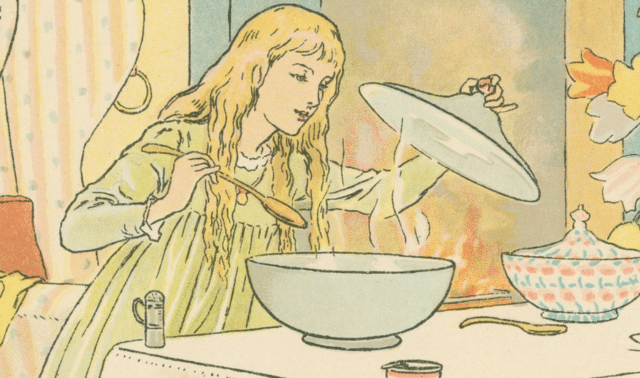
When writing a family story, too many flowery words can drag down a narrative. But stark facts alone won’t ignite your reader’s imagination. What is the right amount of detail to ensure a compelling read?
When reading others’ work, you might find yourself (like Goldilocks) thinking “This one is too wordy. That one isn’t wordy enough.” This article will help you find the happy medium—the “just right” amount of detail to capture and keep your reader’s attention.
We’ll start with some advice from renowned author John Steinbeck. Detailed descriptions can be delightful to write and read, but you have to find a balance. As he labored over East of Eden, a sprawling work of historical fiction that interweaves some of his own family history, Steinbeck wrote in a letter to his editor:
“I told [my wife] the whole history of the Chinese in California … all of this as a background for the few paragraphs I am going to do today. Lord—if you put down all that went in back of a long book, it would be endless.
“And I must be careful not to overload this book and to keep the story straight and true, when my impulse is to tell everything.”
1. Start With Story
If Steinbeck found it challenging to keep a 225,000-word book in check, it’s no surprise we find it difficult to make every word count in short ancestor stories. You may have a whole heap of research that contains many gems begging to be included. Which will bring the tale you’re telling to life?
First, you must think like a novelist and focus on story. You might feel placing too much emphasis on storytelling is inappropriate when chronicling the life of a real person. After all, you don’t want to force story formulas and tropes on your ancestor’s life.
However, templates and storyboards can be useful tools for helping you identify and enhance the gripping details you’ve found. That structure will help you trim away those parts that won’t be as interesting to readers. In doing so, you won’t be altering the truth—you’ll be acting as an editor, deciding what the story will emphasize. That’s the prerogative of a good writer. I’ve got tips for storyboarding on my website.
The patterns of story structure involve a handful of elements. You’ll be happy to find that true life naturally unfolds in patterns, meaning you won’t need to stretch the truth to find and build a narrative. Each story needs:
- At least one character
- An inciting incident—something that happens and sends the character(s) on a journey
- A conflict or problem
- A theme
- A plot with a defined beginning, middle and end
Look over the research you have on a person or family and find details that line up with these elements.
2. Focus on Vignettes
“Vignettes” are short stories—self-contained episodes that depict a moment in time. Family history writers often find success by zeroing in on a specific event in an ancestor’s life. That event will have an intriguing hook or may serve as the “inciting incident,” mentioned earlier as a key story element.
Vignettes are both easier to write and (usually) more interesting to read. They narrow the focus of a story from an entire lifetime to just a moment, and often leave the audience wondering what will happen next. Once you write the first vignette, you’ll gain confidence to write more in the same style.
A series of vignettes might ultimately make up the structure of your longer story. Writer Kerry Slattery published a short book about her husband’s family. Her narrative opens with a compelling vignette showing life in her main character’s village on the day of his birth. Subsequent vignettes show how the main character’s family left his homeland of Sicily—a pivotal event that changed the whole family’s trajectory. Leaving was the inciting incident.
3. Find Specific, Sensory Details
Next, you’ll pepper your piece with details. Like spices, you want to add just the right amount of flavor. You don’t want to apply too little, nor be too heavy-handed.
Scout for details that convey deeper meanings—those representative of an era or that illustrate someone’s personality. One well-chosen detail can stand in for the rest.
Look for details that are:
Sensory
These awaken the five senses, invoking taste, smell, touch and sound, in addition to sight. For example, a dinner table scene might draw readers into an environment of:
- rich aromas (the smell of a family’s traditional goulash)
- colors (the warm orange glow of flickering candles)
- noises (a terse silence, punctuated by the clinking of silverware)
- textures (an itchy, Sunday’s-best turtleneck sweater the character was forced to wear)
Mealtime can also be an effective backdrop for exposing emotional undercurrents within a family.
Concrete
These lend credibility to your narration, helping your reader better understand the characters and setting. Tangible tidbits from your research will spark the imagination: a child’s favorite toy, a character’s unusual (or colorful!) vocabulary, or an eccentric neighborhood landmark.
Unique and Memorable
You might think a time or place is too obscure to be relatable, but the opposite is true. The more specific your description is, the more readers will put themselves in the shoes of your protagonist—even if the setting is foreign to them. Famed Irish author James Joyce once said “In the particular is contained the universal.”
Keep in mind that less is more when it comes to details. Everything you mention should carry an emotional charge and serve a purpose for the wider story.
4. Describe Characters
At least some of your details should be about your main characters. Consider how they looked and spoke, and what mannerisms they had that hinted at their personalities. Try to go beyond the obvious or the cliché. What were their grooming habits? How was their profession reflected in their home and wardrobe? Was this person conventional, or did they “go against the grain.”
Remember: You want to sprinkle details about characters into your story. Avoid big exposition dumps or describing all of a character’s physical features at once.
For example, writer Rachel Trotter shared how pictures of her grandmother and great-aunt reflected their personalities. In two photos—taken decades apart—the sisters both wear dresses and elegant hats. One sister’s hat is fancier, while the other’s is more conservative. The choice in hat reflects each sister’s tendencies. And their posture (holding hands in both photos) showcases their close relationship.
5. Come Back to a Central Theme
What is your story about—really about? What do you hope to convey, and why are you writing it? What did your ancestors learn from their experience, and what did the story teach you? These questions point to the theme.
Theme becomes your guiding star. Writing expert Robert McKee quotes the great playwright Paddy Chayefsky, who once said, “As soon as I figure out the theme of my play, I type it out in a single line and Scotch-tape it to the front of my typewriter. After that, nothing goes onto the page that isn’t on-theme.”
Likewise, if you cannot answer how something anchors to the core theme of your story, cut it.
Here are some questions to ask yourself when considering whether a detail is relevant to your theme:
- Is this detail symbolic of the story’s meaning?
- Does this detail make the character’s struggle more tangible and relatable?
- Why should readers care about this detail?
6. Free-Write
Catalog the information you’ve found, gathering data without being too analytical. Write quick impressions in a running document as you work; you may only see important threads and themes in a later, fuller draft.
Next, start putting together the structure of your work. Advice from professional historian Jenny Lund has served me well. She advocates writing the first draft quickly and from memory. Don’t worry about the “right” amount of detail in that first draft. Don’t pause to look up sources or quote anyone for more than a few words. You know more than you may realize, so letting it flow this way will allow your voice to shine. This exercise will free you.
Alternatively, you might begin by creating an outline. I do a combination of both, writing a first draft with some spontaneity, then storyboarding after I’ve made more progress.
Regardless of your process, don’t agonize over level of detail or other nitty-gritty subjects (such as word choice or word count) in the first draft. Until you have spent time with a story and are clear on the theme, you cannot be objective about what resonates most. Get the words out, see what flows, and make decisions later.
7. Cut Unnecessary Information
The family history sources you’re consulting rarely have just the right amount of detail to inform your story—the “Goldilocks zone” we’re targeting. You’ll often find either way too much information or struggle to claw out even a few dates and names. Having too much information is easier to solve.
Once you have a draft, outline or storyboard (see No. 6), revisit facts that struck your fancy early in the process. How might they tie into the overall story? What do they mean?
British writer Arthur Quiller-Couch famously instructed writers to “Murder your darlings.” If details or passages (even those that enamor the author) don’t support the story, the author should be prepared to cut them.
When considering even favorite details, ask yourself “So what?” Why does that fact matter to the story? If you can’t answer—or can’t answer yet, because your story is still emerging—you might include a fact because of its historical context or beautiful prose. Use either in moderation.
8. Do More Research
Alternatively, you might have too few details in your work. Even barebone biographical sketches can spur powerful stories. But if you need more information, consider:
- Well-researched historical fiction of the era
- Oral histories from the same community, time or occupation
- Newspapers—not just news articles and obituaries, but the whole publication (including ads and society pages/gossip columns, which tell the comings and goings of “characters” in the area)
- Photos and paintings
- Timelines of historical events, including wars, border changes, and shifts in power structures
These tips will help you write a family history that brings your ancestor’s story to life. Finding the “Goldilocks zone” is one of the most delightful parts of the process. When you do, your work will carry an emotional charge that readers can feel.
Related Reads
A version of this article appeared in the November/December 2024 issue of Family Tree Magazine.











